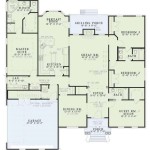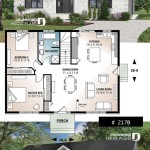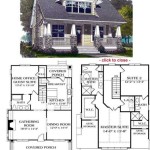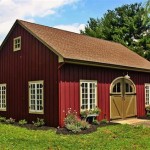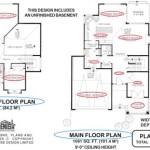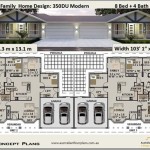How to Make a Floor Plan of Your House
Creating a floor plan of a house is a fundamental step in various processes, from interior design and renovation projects to real estate transactions and emergency planning. A detailed and accurate floor plan serves as a visual representation of the space, enabling effective communication, informed decision-making, and efficient project execution. This article outlines the different methodologies and considerations involved in making a floor plan of a house.
Multiple approaches can be employed to generate a floor plan. These range from manual methods utilizing measuring tools and paper to advanced digital techniques leveraging specialized software and laser scanners. The selection of a specific method hinges on factors such as the desired level of accuracy, the complexity of the house's layout, the available budget, and the individual's technical proficiency.
Manual Measurement and Drafting
The traditional manual method involves physically measuring the dimensions of the house using a measuring tape or laser distance meter. Each room is measured for length, width, and the position of architectural features such as doors, windows, fireplaces, and built-in furniture. Detailed notes are taken to record these measurements alongside any irregularities in the walls or ceilings.
Once the measurements are collected, they are transferred onto graph paper or architectural drafting paper. A chosen scale, such as 1/4 inch equals 1 foot, is used to represent the real-world dimensions on the paper. Walls are drawn as lines, and symbols are employed to represent architectural elements. The precise placement of these elements is crucial for creating an accurate representation of the house's layout. The process requires meticulous attention to detail and a good understanding of scaling principles.
The advantages of the manual method include its affordability and accessibility. It requires only basic tools and no specialized software. However, it is more time-consuming and prone to errors compared to digital methods. The accuracy of the floor plan depends heavily on the precision of the measurements and the draftsman's skill.
To improve the accuracy of a manual floor plan, it is recommended to take multiple measurements of each room and to cross-reference them. This helps to identify and correct any discrepancies. Using a laser distance meter can also significantly improve the accuracy of the measurements. Furthermore, it is advisable to create a rough sketch of each room before taking measurements to ensure that all essential features are included.
Manual drafting often benefits from using architectural symbols consistently. These symbols represent common elements like doors swinging direction, window types, stairs, and plumbing fixtures. Adhering to standard architectural notation improves the readability and universal understanding of the floor plan.
Digital Floor Plan Software
Digital floor plan software offers a more efficient and accurate alternative to manual drafting. These programs provide a user-friendly interface and a range of tools for creating professional-looking floor plans. Many options exist, from simpler programs designed for beginners to more sophisticated software used by architects and interior designers.
Popular digital floor plan software includes offerings such as AutoCAD Architecture, Chief Architect, SmartDraw, and online platforms like Planner 5D and RoomSketcher. Each program has its own set of features and capabilities, but they generally allow users to draw walls, insert doors and windows, add furniture, and specify dimensions with precision.
The process of creating a floor plan with digital software typically involves importing or creating a base plan. Measurements can be entered directly into the software, and walls can be drawn to the specified dimensions. Doors, windows, and other architectural elements can be selected from a library and placed in the appropriate locations. The software automatically calculates areas and dimensions, reducing the risk of errors.
Some digital floor plan software also offers 3D modeling capabilities, allowing users to visualize the house in three dimensions. This can be particularly helpful for interior design projects and for communicating the layout to others. Advanced features, such as lighting simulations and rendering, can further enhance the visualization.
The advantages of using digital floor plan software include increased accuracy, faster drafting, and the ability to make revisions easily. The software also allows for professional-looking presentations and the ability to share the floor plan electronically. However, digital floor plan software can be expensive, and it requires a learning curve to master its features.
Selecting the right digital floor plan software involves considering project needs and the user's technical skills. For basic floor plans, user-friendly online platforms may suffice. For complex architectural designs, professional-grade software with advanced features is necessary. Trial versions of software can be useful for evaluating different options before making a purchase.
Regardless of the software chosen, ensuring accurate input of measurements is paramount. Digital tools minimize human error in calculation, but incorrect initial data will still propagate inaccuracies throughout the entire floor plan.
Laser Scanning and Point Cloud Technology
For maximum accuracy and efficiency, laser scanning technology offers a sophisticated solution for creating floor plans. Laser scanners use laser beams to measure the distance to surfaces, creating a dense point cloud of data representing the house's interior. This point cloud can then be imported into software to generate a highly accurate floor plan.
The process involves setting up the laser scanner in different locations within the house and allowing it to scan the surrounding environment. The scanner captures millions of data points, creating a three-dimensional representation of the space. The data is then processed to remove noise and to align the different scans.
Once the point cloud is generated, it is imported into specialized software designed for floor plan creation. The software allows users to trace the walls, doors, windows, and other architectural features based on the point cloud data. The software can automatically generate a floor plan with precise dimensions and accurate placement of elements.
Laser scanning offers several advantages over manual measurement and digital floor plan software. It is significantly faster and more accurate, particularly for complex layouts and irregular shapes. It also captures a detailed record of the house's interior, which can be useful for future renovations or maintenance.
However, laser scanning is the most expensive method for creating floor plans. It requires specialized equipment and expertise, and it may not be cost-effective for small or simple projects. The data processing also requires significant computing power and software skills.
The use of laser scanning is typically employed in professional settings by surveyors, architects, and contractors. Its level of accuracy and detail make it ideal for large-scale projects, historical preservation, and situations where pinpoint precision is critical.
Key Elements of an Accurate Floor Plan
Regardless of the method used, certain elements are crucial for an accurate and informative floor plan. These elements ensure that the floor plan is easily understood and can be used effectively for its intended purpose.
Firstly, exterior and interior walls must be represented accurately, including their thickness and material (if relevant). Doors and windows should be placed correctly, with symbols indicating the swing direction of doors and the type of window. The position of fixed elements such as stairs, fireplaces, and built-in cabinets should also be shown accurately.
Dimensions should be clearly labeled on the floor plan, indicating the length and width of each room, as well as the overall dimensions of the house. The scale of the floor plan should be indicated, allowing users to accurately interpret the dimensions. A north arrow should be included to orient the floor plan correctly.
The floor plan should also include notations for plumbing fixtures, electrical outlets, and other utilities. These notations can be helpful for planning renovations or for identifying potential issues. Furniture and other movable objects can be included in the floor plan to provide a sense of scale and to visualize the layout of the rooms.
For complex layouts, it may be useful to create separate floor plans for each level of the house. Each floor plan should be clearly labeled with the floor number and any relevant information, such as the location of stairs and elevators. It can also be helpful to include section views to show the relationship between different levels.
The level of detail included in the floor plan depends on its intended use. For simple space planning, a basic floor plan with accurate dimensions may be sufficient. For more detailed projects, such as renovations or interior design, a more comprehensive floor plan with detailed notations is necessary.
Consistency in applying architectural symbols and line weights enhances the clarity of the floor plan. Standard conventions are widely understood and prevent ambiguity, making it easier for others to interpret the plan accurately.
Ensuring Accuracy and Usability
Accuracy is paramount when creating a floor plan. It is essential to double-check all measurements and to verify the accuracy of the drawing. Errors in the floor plan can lead to costly mistakes during renovations or construction projects. Usability is also a key consideration. The floor plan should be easy to read and understand, with clear labeling and consistent symbols.
To ensure accuracy, it is recommended to take multiple measurements of each room and to compare them. If there are any discrepancies, they should be investigated and resolved. Using a laser distance meter can significantly improve the accuracy of the measurements. It is also helpful to have someone else review the floor plan for errors.
To improve usability, the floor plan should be printed in a large enough size to be easily readable. The labeling should be clear and concise, and the symbols should be easy to understand. The floor plan should be organized logically, with rooms grouped together according to their function.
The format of the floor plan should also be appropriate for its intended use. For example, a floor plan that is intended to be shared electronically should be saved in a common file format, such as PDF or JPG. A floor plan that is intended to be used for construction or renovation should be printed on durable paper and protected from the elements.
Regularly updating the floor plan is important, particularly after any renovations or modifications to the house. An outdated floor plan can be misleading and can lead to errors. Keeping the floor plan current ensures that it remains a valuable tool for planning and decision-making.
Beyond the basic layout, consider adding details that enhance usability in specific contexts. For example, marking the location of smoke detectors and fire extinguishers is beneficial for emergency planning. Indicating the direction of sunlight at different times of day can aid in interior design choices.

Create And Visualize House Plans In Minutes Roomsketcher

Floor Plans Solution Conceptdraw Com

Playing Architect With Floorplanner Making 2d House Plans Young Love

Designing My Own House

Free Floor Plan Creator Design 2d 3d Layouts Easily

What Makes A Good Floor Plan

Can A Custom Builder Make My Floor Plan Bigger 5 Ways To Add Square Footage Travars Built Homes

How To Design A House From Sketch Reality

Free Floor Plan Creator Design 2d 3d Layouts Easily

My Dream House
Related Posts


